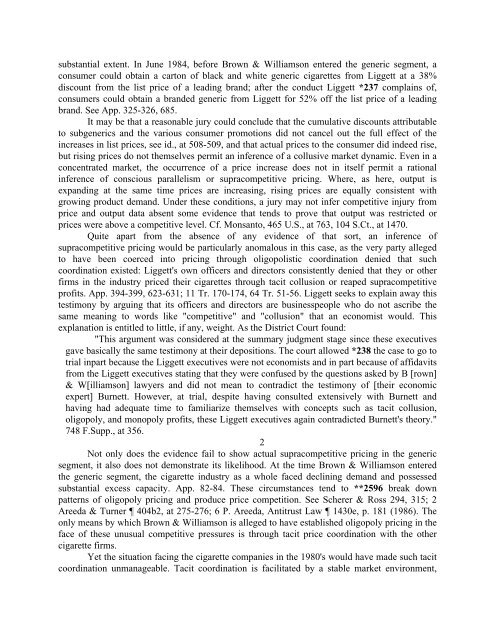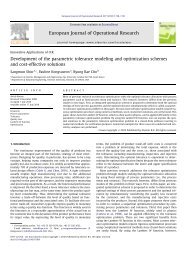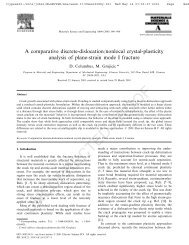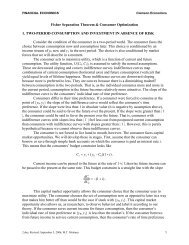509 U.S. 209, 113 S.Ct. 2578 BROOKE GROUP LTD., Petitioner v ...
509 U.S. 209, 113 S.Ct. 2578 BROOKE GROUP LTD., Petitioner v ...
509 U.S. 209, 113 S.Ct. 2578 BROOKE GROUP LTD., Petitioner v ...
Create successful ePaper yourself
Turn your PDF publications into a flip-book with our unique Google optimized e-Paper software.
substantial extent. In June 1984, before Brown & Williamson entered the generic segment, a<br />
consumer could obtain a carton of black and white generic cigarettes from Liggett at a 38%<br />
discount from the list price of a leading brand; after the conduct Liggett *237 complains of,<br />
consumers could obtain a branded generic from Liggett for 52% off the list price of a leading<br />
brand. See App. 325-326, 685.<br />
It may be that a reasonable jury could conclude that the cumulative discounts attributable<br />
to subgenerics and the various consumer promotions did not cancel out the full effect of the<br />
increases in list prices, see id., at 508-<strong>509</strong>, and that actual prices to the consumer did indeed rise,<br />
but rising prices do not themselves permit an inference of a collusive market dynamic. Even in a<br />
concentrated market, the occurrence of a price increase does not in itself permit a rational<br />
inference of conscious parallelism or supracompetitive pricing. Where, as here, output is<br />
expanding at the same time prices are increasing, rising prices are equally consistent with<br />
growing product demand. Under these conditions, a jury may not infer competitive injury from<br />
price and output data absent some evidence that tends to prove that output was restricted or<br />
prices were above a competitive level. Cf. Monsanto, 465 U.S., at 763, 104 S.<strong>Ct</strong>., at 1470.<br />
Quite apart from the absence of any evidence of that sort, an inference of<br />
supracompetitive pricing would be particularly anomalous in this case, as the very party alleged<br />
to have been coerced into pricing through oligopolistic coordination denied that such<br />
coordination existed: Liggett's own officers and directors consistently denied that they or other<br />
firms in the industry priced their cigarettes through tacit collusion or reaped supracompetitive<br />
profits. App. 394-399, 623-631; 11 Tr. 170-174, 64 Tr. 51-56. Liggett seeks to explain away this<br />
testimony by arguing that its officers and directors are businesspeople who do not ascribe the<br />
same meaning to words like "competitive" and "collusion" that an economist would. This<br />
explanation is entitled to little, if any, weight. As the District Court found:<br />
"This argument was considered at the summary judgment stage since these executives<br />
gave basically the same testimony at their depositions. The court allowed *238 the case to go to<br />
trial inpart because the Liggett executives were not economists and in part because of affidavits<br />
from the Liggett executives stating that they were confused by the questions asked by B [rown]<br />
& W[illiamson] lawyers and did not mean to contradict the testimony of [their economic<br />
expert] Burnett. However, at trial, despite having consulted extensively with Burnett and<br />
having had adequate time to familiarize themselves with concepts such as tacit collusion,<br />
oligopoly, and monopoly profits, these Liggett executives again contradicted Burnett's theory."<br />
748 F.Supp., at 356.<br />
2<br />
Not only does the evidence fail to show actual supracompetitive pricing in the generic<br />
segment, it also does not demonstrate its likelihood. At the time Brown & Williamson entered<br />
the generic segment, the cigarette industry as a whole faced declining demand and possessed<br />
substantial excess capacity. App. 82-84. These circumstances tend to **2596 break down<br />
patterns of oligopoly pricing and produce price competition. See Scherer & Ross 294, 315; 2<br />
Areeda & Turner 404b2, at 275-276; 6 P. Areeda, Antitrust Law 1430e, p. 181 (1986). The<br />
only means by which Brown & Williamson is alleged to have established oligopoly pricing in the<br />
face of these unusual competitive pressures is through tacit price coordination with the other<br />
cigarette firms.<br />
Yet the situation facing the cigarette companies in the 1980's would have made such tacit<br />
coordination unmanageable. Tacit coordination is facilitated by a stable market environment,
















